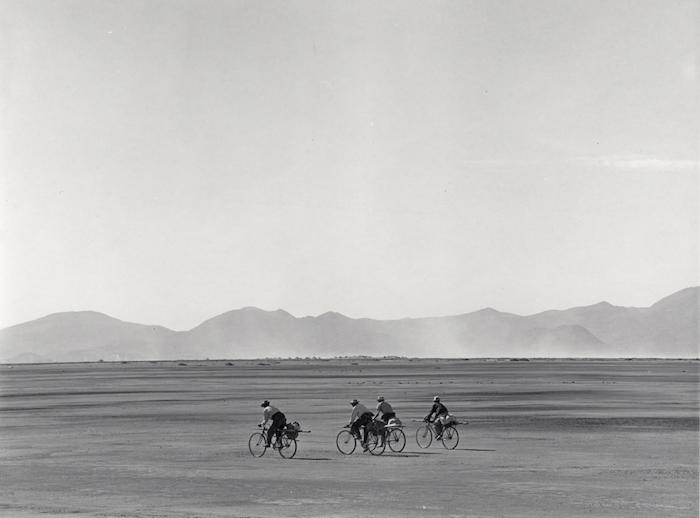[A photograph in black and white. Four distant people ride bicycles across flat plains with mountains in the background.]
Manuel Álvarez Bravo
Bicycles on Sunday , 1968
Artwork Type: Photographs
Medium: Gelatin silver print
Dimensions: 8 x 10 in. (20.32 x 25.4 cm)
Accession #: 19800724N
Credit: Collection of University Art Museum, University at Albany, State University of New York on behalf of The University at Albany Foundation, gift of Ronald Lesser
Related Exhibitions:
Regarding Place: Photographs From The University Art Collections
Affinities and Outliers: Highlights from the University at Albany Fine Art Collections
Copyright: © Manuel Álvarez Bravo
Object Label:
Show Object Label(s)Manuel Álvarez Bravo (1902–2002, Mexican) was one of the most renowned Mexican artists of the twentieth century. His work not only became a significant part of but also expanded the canon of black-and-white photography. His oeuvre shares the visual vocabulary of the North American photographers included in Affinities and Outliers such as Edward Steichen and Elliott Erwitt. He was particularly influenced by indigenous cultures of Mexico, but remained open to artistic influences from outside his country. Working alongside artists such as Frida Kahlo and José Clemente Orozco, Bravo’s portraiture and landscapes draw from pictorial, surreal, and documentary photography. Encompassing a wide breadth of subject matter, the artist’s series of fifteen black- and-white works exemplify Bravo’s ability to transcend culture, time, and place.
–Affinities and Outliers: Highlights from the University at Albany Fine Art Collections
Mexican, born Mexico City, 1902, died 2002
Manuel Álvarez Bravo is considered one of the most significant figures in the history of photography and one of the great Mexican artists of the twentieth century. Like his contemporaries––Diego Rivera, José Clemente Orozco, David Alfaro Siqueiros––he was influenced by the indigenous culture of Mexico throughout his career, but also remained open to artistic influences outside his country. In his work he combined elements of Pictorialist photography, Modernist abstraction, surrealism, and documentary photography, creating an art that transcended culture, time, and place. Many of his photographs of the Mexican landscape reflected his recurrent themes, such as sympathy for the working class, an air of mystery, a sense of the surreal, and a preoccupation with death.
Álvarez Bravo had over 150 individual exhibitions and participated in over 200 collective exhibitions. His work is in numerous collections including the Museum of Modern Art, New York; Philadelphia Museum of Modern Art; Instituto Nacional de Bellas Artes (Museo de Arte Moderno), Mexico City; Fonds National d'Art Contemporain, France; and the Art Institute of Chicago.
–Regarding Place: Photographs From The University Art Collections
Manuel Álvarez Bravo is widely credited as the most important Latin
American photographer of the 20th century, with a career spanning seventy
years although the artist was mostly self-taught. Much of his important
work was done after the Mexican Revolution that thrust the country into
a period of modernization. Bravo explores this rapid modernization in his
photographs, while also diving into his Mexican roots and heritage. Many
of his photographs capture people, buildings, and objects of the ordinary,
but usually in a surrealist and anti-picturesque way. Early on Bravo was
influenced by many European photographers, but soon become enamored
by Mexican muralists like Diego Rivera. In works like Bicicletas en domingo,
Bravo is able to absorbed the stereotypes of the picturesque Mexico within
the vast desert and mountains in the background, but subverts this by
capturing an everyday moment through a leisurely ride of bicyclists on a
Sunday afternoon.
–Double Play
Please contact us at dabbatiello@albany.edu to verify collection holdings and artwork information. If you are interested in receiving a high resolution image of an artwork for educational, scholarly, or publication purposes, please contact us at dabbatiello@albany.edu.
